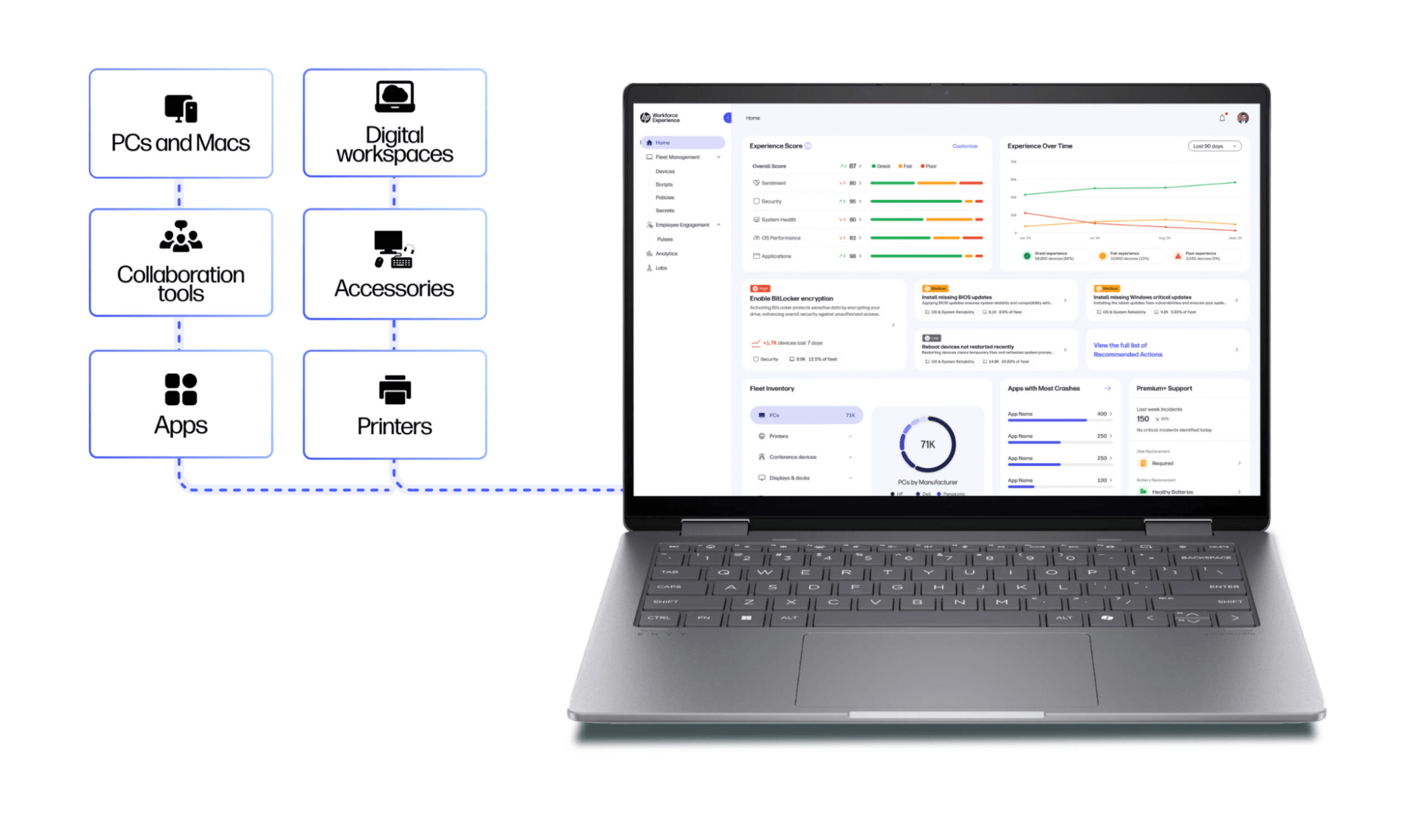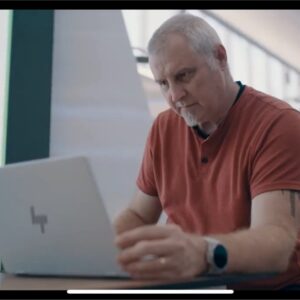Leveraging Powerful Device Data to Make the Right Tech Investments

Table of contents
Enterprise IT leaders are leveraging data-driven insights to improve fleet management. Here’s how smarter investments are boosting employee productivity and maximizing ROI.
How can you minimize total cost of ownership (TCO) of your IT investments without sacrificing system performance or impacting the user experience? It’s one of the biggest challenges facing IT leaders today. Whether it’s managing technology systems, supporting business operations, or investing in connectivity, licenses, warranty fees, or equipment, IT teams must constantly balance the needs of the business while getting the most out of their investments.
In today’s remote and hybrid work environment, where almost every company has three versions of each employee (in office, at home, and on-the-go), it’s a thankless job that’s only getting harder—and more expensive.
According to Gartner®, worldwide IT spending is expected to soar to $5.74 trillion in 2025, an increase of 9.3% from 2024. Devices and peripherals make up a huge chunk of investments, accounting for about 14% of total IT budgets.

Source: Press Release, Gartner Forecasts Worldwide IT Spending to Grow 9.3% in 2025, October 23, 2024. GARTNER is a registered trademark and service mark of Gartner, Inc. and/or its affiliates in the U.S. and internationally and is used herein with permission. All rights reserved.
Companies are taking back control
Even with costs on the rise, IT teams need to make sure employees have the right technology to do their jobs wherever and whenever they work. They also need to show the value of their investments, cut costs, maximize the lifespan of devices and peripherals, and align spending with business goals.
That’s why companies are increasingly adopting a data-driven strategy to manage the growing complexity of their device fleets using telemetry data. They’re gaining deeper insights on usage patterns, such as CPU, memory, and disk utilization trends, battery and hard drive health, and more. In addition to identifying emerging trends and issues, this granularity allows them to optimize device lifecycles and give employees the right tools for their jobs based on how they actually work, resulting in higher productivity, lower IT spending, and greater ROI.
At HP, our internal shift to telemetry-powered fleet management resulted in a drastic reduction in PC refresh costs across the entire organization. Not only can these savings be used to fund other strategic initiatives, the shift from reactive to proactive asset management has reduced digital friction, streamlined support processes, improved sustainability, and delivered a more engaging digital experience to HP employees.
Start by Identify Your IT Challenges
The first step in slashing costs and maximizing ROI begins with identifying your IT challenges. For example, a large portion of the annual budget goes to procurement, maintenance, and retirement of devices such as PCs, printers, and collaboration equipment. In the past, managing device life cycles was straightforward as they were mostly kept in the office which simplified asset tracking and management.
That’s all changed with the shift to a hybrid workforce. For example:
- A wider range of devices and bring-your-own-device (BYOD) policies make asset management more complex.
- The COVID-19 pandemic and global supply chain disruptions highlighted the need for flexible upgrade options to extend device lifespans and avoid costly, delayed bulk purchases.
- Traditional 3-year to 5-year device refresh cycles overlook factors like device performance and usage patterns. Without better insights, companies may prematurely replace perfectly fine devices or rely too long on outdated equipment.
- Hybrid work adds complexity to asset management, requiring IT to monitor and track devices across diverse environments and usage patterns. This shift demands more advanced asset management tools.
With that in mind, the five fundamental questions that IT departments typically need answers to include:
What assets do we have?
This question focuses on establishing a comprehensive inventory of all IT assets within the organization.
Who has them?
Understanding which employee is using which device is crucial for tracking responsibility, usage patterns, and potential security risks.
Where are they located?
This question has become increasingly important with the rise of the hybrid workforce. Knowing the location of each device is essential for security, maintenance, and recovery purposes.
How are they performing?
Monitoring device performance helps identify potential issues, optimize resource allocation, and ensure employees have the tools they need to be productive.
How can we optimize their performance?
Businesses want to take a proactive approach to IT investment management, focusing on uninterrupted performance while maximizing ROI. The IT budget normally allocated to device refreshes could be deployed across other parts of the business, potentially driving sales or enhancing operational efficiency.
These five questions provide a framework for effective IT investment management. By utilizing modern fleet management solutions, IT departments can stretch their investment dollars further by making informed decisions about device allocation, upgrades, replacements, security protocols, sustainability, and more.
Leverage Employee Usage Data to Power Fleet Management
Tackling modern IT challenges requires a new, more holistic approach than in the past. Today, companies are moving from traditional IT asset management (primarily concerned with inventory and basic lifecycle tracking) to fleet management (which prioritizes understanding device performance and user experience) to optimize the entire technology ecosystem. The magic lies in telemetry data, or the detailed information gathered from devices about their usage and performance.
Telemetry provides IT leaders with the insights they need to make more strategic decisions about their assets under management. Advantages include:
- Need-based replacement: Instead of automatically replacing devices based on age, decisions can be made based on actual performance and user needs. This prevents unnecessary spending on devices that are still functioning well and ensures employees have the right tools for the job.
- Proactive IT support: Identifying potential issues before they impact users enables IT to address them proactively, minimizing downtime and productivity loss.
- Extended lifecycles: Devices that might have been prematurely replaced can be given a second life through targeted upgrades, like adding memory or replacing batteries. This not only saves money but also aligns with sustainability goals.
- Optimized device allocation: By creating and understanding user personas and their specific requirements, IT can match the right devices to the right users, ensuring that everyone has the tools they need to be productive and engaged. For example, a lightweight laptop may be better suited for a road warrior who frequently travels, while a powerful workstation is necessary for an engineer running complex simulations.
- Lower TCO: By making smarter decisions about upgrades, replacements, and device allocation, organizations can optimize IT spending and improve the total cost of ownership (TCO).
Modern digital employee experience (DEX) platforms provide intelligent fleet management solutions. Smarter insights gained from better telemetry empower IT to make more strategic, cost-effective, and user-centric decisions, ultimately driving greater ROI from their technology investments.
Improve ROI with the HP Workforce Experience Platform

The HP Workforce Experience Platform delivers a new approach to IT investments, merging traditional IT asset management with modern fleet management and AI-driven insights.
The Platform provides a holistic view of the entire IT investment, not just PCs, and covers printers, collaboration tools, and other peripherals. Powered by telemetry from over 38 million devices, it analyzes usage patterns while tying in device lifecycle status, warranty status, and sustainability metrics such as power consumption and carbon footprint. Companies can create a customized catalog of approved devices, which they can match to employee personas with user-specific usage patterns.
The platform also goes far beyond age-based refresh cycles. It identifies underused or overused assets and recommends replacements based on how well they’re actually working for the user. In addition to lower costs, HP found that this targeted approach improved their employee satisfaction scores by as much as 70%. With a more holistic view of device health and employee needs, HP Workforce Experience Platform helps businesses optimize device lifecycle management to keep their employees happy and productive.
The Future of IT Is Data-Driven and Employee-Centric
For today’s enterprise businesses, a data-driven IT investment strategy is more critical than ever. Telemetry can eliminate age-based refresh cycles and help IT leaders make smarter decisions about devices. This approach drives cost savings, maximizes ROI, and boosts productivity by ensuring employees have the right tools they need—all while optimizing IT budgets.
The HP Workforce Experience Platform takes IT asset management further, combining AI-powered insights, comprehensive fleet management, and employee engagement to give IT teams a complete view of device health and employee needs. With the right technology, companies can tackle the challenges of the modern workforce and improve the employee experience, while getting the most out of their investments.
HP Workforce Experience Platform¹ is a comprehensive and modular digital employee experience solution that enables organizations to optimize IT for every employee’s needs.
Subscribe to the blog or schedule a consultation with our team to begin optimizing your IT capabilities today.
¹At launch, some advanced features require a subscription.
From the blog
The latest industry news, interviews, technologies, and resources.
Unlocking Outlier Detection Across the Digital Employee Experience
What Is the IT Asset Lifecycle? How to Maximize ROI from Your IT Investments
Top Three Takeaways from the Gartner Digital Workplace Summit 2025





